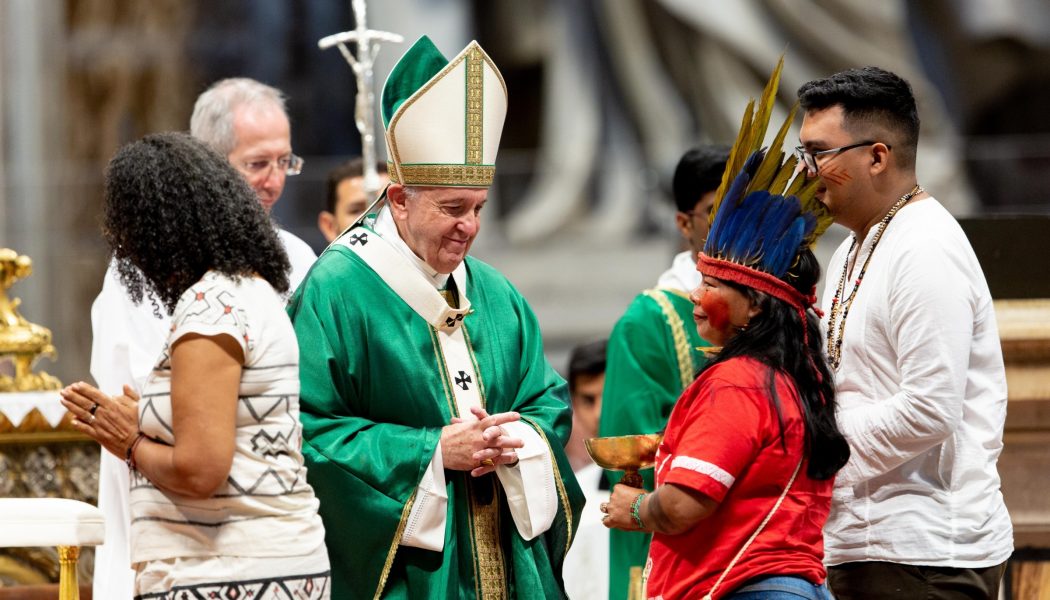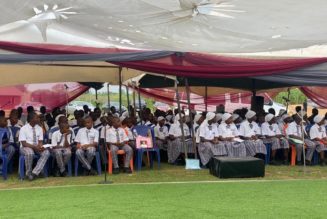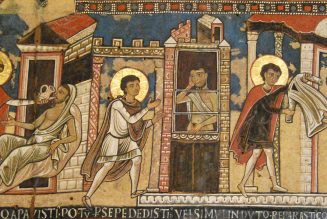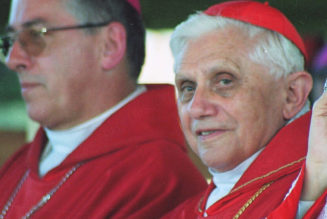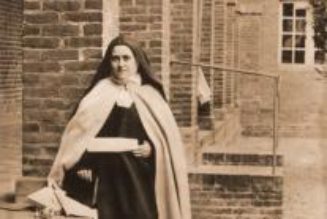
Pope Francis at the Opening Mass of the Synod of Bishops on the Amazon region, Oct. 6, 2019. (Daniel Ibáñez/CNA)
“The entire letter is written in a personal and attractive tone. The Successor of Peter [wants] to win all Catholics and Christians of other denominations, but also all people of good will, for a positive development of this region,” so that “all living there may experience the uplifting and unifying power of the Gospel.”
A Document of Reconciliation
On Pope Francis’ Post-Synodal Letter Querida Amazonia
By Cardinal Gerhard Müller
Amid great hopes and anxious fears, the post-synodal letter has arrived. It refers to the final document of the Amazon Synod on October 6-27, 2019, and the Pope does not draw from it any dramatic and disconcerting conclusions.
Rather, he wishes to offer the Church and all people of good will his own answers, in order to help to ensure a “harmonious, creative and fruitful reception of the whole synodal process” (Art. 2).
The letter is divided into four chapters, each representing a dream, or vision, for the important and magnificent region of Amazonia: 1. A Social Dream (art. 8-27); 2. A Cultural Dream (art. 28-40); 3. An Ecological Dream (art. 41-60) and 4. An Ecclesial Dream (art. 61- 110). The Conclusion (Art. 111) presents an overall view of the challenges and opportunities for this country. The Pope concludes with a beautiful and profound prayer to Mary, Queen of the Amazon, in whose spirit we recognize, proclaim and spread the universal reign of God in Jesus Christ, her Son.
The entire letter is written in a personal and attractive tone. The Successor of Peter, as the universal shepherd of Christ’s flock and as the highest moral authority in the world, wants to win all Catholics and Christians of other denominations, but also all people of good will for a positive development of this region, so that our fellow men and fellow Christians living there may experience the uplifting and unifying power of the Gospel. We are to work together, locally and globally, in solidarity for the common good. The Pope does not want to fuel existing political, ethnic and inner-Church conflicts and conflicts of interest, but rather to overcome them. May all take the Holy Father as a model for themselves, for the promise is valid for all: “Blessed are the peacemakers, for they will be called children of God. (Matthew 5:9).
The hermeneutic, that is, the basic attitude when reading this papal letter, can be drawn by a Catholic only from the Catholic faith. It is not characterized by dialecticism, but on the basis of analogy. The Catholic way of thinking, which gives us a clear guideline for bringing all the statements of the revealed faith and the philosophical, scientific and everyday knowledge of the world into a synthesis, does not start from the opposition of nature-culture and grace-belief, but from their distinction and simultaneous relationship to one another. On the one hand, there is the comprehensive orientation towards God, his works of creation, redemption and reconciliation belong together, and on the other, responsibility for the world, the family, community, the state.
Christ is the Redeemer from sin and the liberator from inhuman structures that come from sin. We still live in a transitory world in the hope of what is to come. But the old world of death and evil is basically already overcome by the crucified and risen Lord. The orientation towards the end times and the return of Christ as Judge and Savior at the end of the world includes cooperation in the building of his kingdom as well as protest and struggle against the inhumane, heartless and exploitative aspects of old and new colonialism. The Native Americans sing a lament about this that cries out to heaven. We, too, hear the “cry of the Amazon region” because we belong to the same people of God (Art. 47f.).
In the first three chapters of this letter, everyone can only agree with the Holy Father with all their heart. This does not exclude the possibility that some details could be evaluated differently by experts, or even presented in greater detail. But the whole text is a pastoral letter of prophetic power that cannot be read like a dispassionate scientific study. Nor can the criteria of a theological textbook be applied in a know-it-all manner, because it is about proclaiming the liberating power of the gospel of Christ and not an academic study.
This text could also have the reconciling effect of reducing internal Church factions, ideological fixations and the danger of inner emigration or open resistance. It is to be hoped that the interpreters of this document will refrain from unnecessary harshness and take up the concerns of the Holy Father like true sons and daughters of the Church in a spirit of agreement and collaboration.
In Chapter 4, beyond the people of good will as subject, the Pope now addresses directly the faithful and their Pastors, namely, bishops and priests. In the Pastoral Constitution “Gaudium et Spes,” the Second Vatican Council had described the place of the “Church in the world of today,” while the Dogmatic Constitution on the Church, “Lumen Gentium,” had described the divine origin from within — the sacred nature and the universal mission of the Church in Martyria, Leiturgia and Diakonia. For this reason, the Pope emphasizes the Christological center of the Church and the universal missionary mandate, in order to avoid any idea of reducing the Church to a political or humanist organization in the manner of an NGO (cf. Art. 62-65).
The inculturation of the one Gospel in the Church of all times and places means reciprocal teaching and learning, giving and receiving at all levels and in all regions of the Church, as we have known since New Testament times. Pentecost is the paradigm of all forms and possibilities of inculturation. This also applies to the understanding of the relationship between the unique revelation concluded in Christ and its realization in the living tradition. This can be verified in view of the Dogmatic Constitution on Divine Revelation “Dei verbum” (Art. 7-10). Inculturation is measured by the presence of grace in creation, by the God-human unity of Christ and the sacramental sign of grace. Sacramental symbolism, in fact, involves the whole person in his or her bodily and social reality in the relationship with God the Father and the Son and the Holy Spirit. This is summed up brilliantly in Art 109.
It is true that the Church has never rejected everything that came from paganism. This is not only true of Greek philosophy and the wisdom of the nations. Also the myths, legends and stories can be excluded in their existential meaning and made fruitful for the mission, as happened both in Ancient Greece (see Hugo Rahner, Greek myths in Christian interpretation, Basel 1984) and in the missionary work of the Germanic peoples. But the fine line between worship of the Creator and worship of the created as if it were God (Rom 1:23) must not be forgotten (Art. 79-80).
In the sense of the defined doctrine of faith, it is clearly stated that the priest is sacramentally conformed to Christ, the head of the Church, by virtue of ordination. Therefore, only a man can symbolically and sacramentally represent Christ as the Bridegroom of the Church, his Bride (Art. 101). But the hierarchical constitution of the Church does not consist in the fact that bishops, presbyters and deacons have political power over the laity. Nor do they stand between God and the (non-consecrated) faithful by interfering with their personal directness to God in prayer and conscience. They have holy authority (potestas sacra) so that God Himself speaks his Divine Word through their human word, so that in the Sacraments, God communicates his grace, and so that, through them, as shepherds, Christ himself feeds his sheep and lambs.
The approach to defining the nature of the priesthood through the exclusive power to offer the Eucharistic Sacrifice and to administer the Sacrament of Penance and the Anointing of the Sick, while not misleading, falls short. Bishops and priests represent Christ, in whom he has the total ministry of teaching, sanctifying and governing (Lumen gentium 26-28; Presbyterorum ordinis 4-6). The lay faithful are not defined by the fact that they can do everything except that which is exclusively reserved to priests, but by their participation in the total mission of the Church on the basis of Baptism and Confirmation. But the importance of the ecclesial ministries of laymen and women, who “are called in various ways to direct collaboration with the apostolate of the hierarchy,” is rightly recalled. (Lumen Gentium 33). For men and women, it is essential not to fall into functionalism (Art. 87). Christ the eternal Son of the Father became man as man; but he became so through a creature — a woman, his mother Mary (art. 101).
In this mystery, which the Fathers of the Church have already recalled time and again, the collaboration of the ordained Pastors in the hierarchical priesthood and of the laity, but also of men and women, is to be lived spiritually by virtue of the common priesthood of all the faithful (Lumen Gentium 10).
The Church’s urgent concern is expressed that even in remote areas the Catholic faithful have more frequent and deeper access to the Eucharist. There is also a need for more pastoral workers who, by their origin, mentality and formation, are closer to the people there. But a solution, which is praised all too pragmatically by many in the consecration of viri probati, would not be a relativization of celibacy in the Latin Church (Art. 85-86). For with it, the Church would, in the epochal challenge of postmodern secularism, dispense with the most effective remedy — namely that the servants of the kingdom of heaven symbolically renounce marriage for the sake of the kingdom of God (Mt 19:12; 1 Cor 7:32ff).
Let us simply leave the last word to the Lord in this overwrought discussion. Christ was “full of compassion for the tired and exhausted people who were like sheep without a shepherd.” And He tells us the same as He told His disciples then: “The harvest is abundant but the laborers are few; so ask the master of the harvest to send out laborers for his harvest.” (Mt 9:37f).
